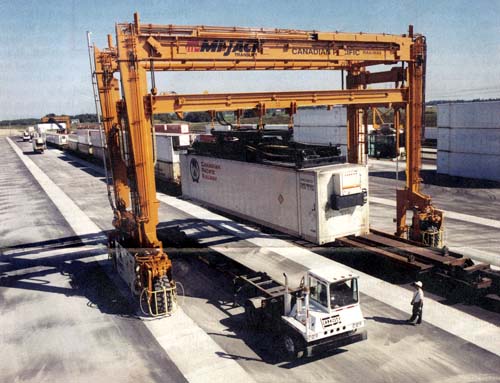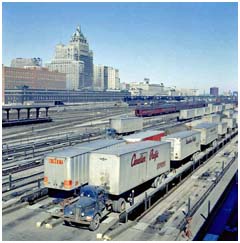|
The Future of Railroading
Greg Gormick Correspondent

THE NEW: Today, mobile gantry cranes such as this one at Vaughan Intermodal Facility
in Toronto straddle tracks and roadways to move intermodal containers quickly between truck chassis and rail
cars.
Toronto - On the night of 1 Dec 1952, CPR intermodal service was born. In
Toronto and Montreal, railway-owned piggyback truck trailers were loaded onto flatcars and the first trains were dispatched for their high-speed trips between
Canada's two major cities. In a land still largely ruled by the steam locomotive and the boxcar, it was a revolution.
Their Wildest Dreams
There were some sceptics outside the CPR who wondered: Could you teach an old iron horse new tricks? Today, the answer is obvious. If they could see it
today, it would surely dazzle the railroaders who created it and the critics who initially questioned it, exceeding their wildest dreams. Starting as but one
limited transportation product offered on a single traffic lane, it has become a virtual railway unto itself.
| |

AND THE OLD: CPR
Intermodal was mostly "piggyback" when this shot was taken in Toronto, back in the
mid-1960s.
|
From two terminals in 1952, CPR intermodal service now reaches 21 across the system, and many more beyond,
thanks to an increasing number of interline agreements with other railways. Alongside domestic intermodal, double stacked containers, owned by global steamship
lines, move from the major ports of North America to its heartland and back again.
Containers owned by the railway or by shippers handle everything from soup to nuts, literally, within and between all three nations of the NAFTA trading block.
And CPR's unique Expressway service provides a trailer-on-flatcar system that whisks time-sensitive goods in shipper or trucker-owned trailers on
quick-loading, five-pack flatcars in the Montreal-Toronto-Detroit market, one of the most truck-competitive in the world. Today, intermodal is the largest of
the CPR's seven commodities groups: 917,000 loads and $804 million in revenue in 2001.
It's proof that railroaders can work with, not against, truckers to provide a transportation package that extracts the best from each mode. It is, say some
industry analysts, the future of railroading.
"We're more like a trucking business than a railway," says Lawre Allen, vice-president, intermodal and automotive. "We're much closer to the
consumer than anywhere else on the railway. That requires constant attention to the customers, quickly matching our service to their demands. It also requires
that we understand their business and even anticipate their needs before they do."
One of the ways that Lawre's group has been growing intermodal has been through the creation of freight villages, or freight cooperatives, encouraging
customers such as Consolidated Fastfrate, Sears, and Canadian Tire to relocate adjacent to the recently-expanded Vaughan and Calgary terminals.
"No other railway has done this," Lawre says. "We're working on other similar developments, such as the Westfair Foods distribution terminal for
food products in Vancouver. Intermodal is going to continue to grow rapidly, not so much through new intermodal products, but by refining and expanding these
existing, service-proven products. Trucks still have 75 percent of the market, so there's lots of room for growth."
Throughout 50 years of intermodal service, CPR has been an industry leader and innovator. In the 1960s, the company electrified the industry by testing the
container concept with a domestic express parcel service on passenger trains in central Canada. That revenue test laid the groundwork for the container
revolution of the late 1960s when import and export goods began moving en masse in unit trains linking Canadian markets with England and Europe.
An interesting aspect of this pioneer service was the modification of old sleeping car frames to haul the containers. Not only did it make good use of existing
equipment with plenty of remaining service life, but it provided container carriers that were already outfitted with all the necessary running gear to run in
passenger consists.
CPR's commitment to containerization, in the form of constant investment and service improvement, has made our Montreal-Toronto-Detroit-Chicago line the
world's largest port-to-market rail route. And by combining similar improvements with the natural advantages of a route that puts New York 800 miles closer to
the Orient than any other, the CPR has built its Chicago-Vancouver corridor into a major trade route.
More to be Gained
The benefits of the multi-modal box were demonstrated further when CPR rolled out North America's first full domestic container service in 1979, beginning the
replacement of piggyback trailers across the entire transcontinental and cross-border system. Domestic container traffic now accounts for more than 40 percent
of the CPR's total intermodal business. There is more to be gained.
"To get it, we have to be competitive on rates, and provide a service that is consistently reliable," says John McBoyle, CPR's general manager for
domestic intermodal. "That's how we've won perishable traffic from food producers such as Parmalat, Nestle's, Kellogg, and Coca-Cola. And we are selling
our services to smaller customers through a team of account managers who have a real stake in making sure that we win back that business. There's lots of room
for growth in both those markets."
There are also many opportunities for intermodal growth between the three NAFTA partners. In Chicago, Dave Wheeler, CPR's senior account manager' for domestic
intermodal, is working to secure more of that traditionally truck-hauled business.
"To realize those tremendous possibilities, you have to be sensitive to the fact that U.S. domestic and cross-border traffic is different," Dave says.
"You can see that in the equipment most shippers have been using. It's a 98-to-2 split between containers and trailers in Canada, but we've still got 30
percent in trailers in the U.S. We're showing customers the advantages of containers, with their lower weight, height, and centre of gravity, as well as their
suitability for stacking in yards and en route. It's changing them over. As well, there's a lot of intermodal business across the borders to Canada and Mexico
that requires an interline partner, we're accomplishing both of those objectives through equipment leasing companies shared with the other roads."
As a member of both the Equipment Management Program, led by Union Pacific, and the North American Container System, established by Burlington Northern Santa
Fe, CPR is now part of two large pools of equipment and a strategic partnership with those two lines and others. All the U.S roads now have a greater incentive
to make maximum use of those containers through interlining.
"There's a natural flow in both directions for traffic moving across the border," Dave says. "You can get full utilization by shipping
resource-based commodities to California, for example, and back haul with perishable traffic to southern Ontario and Quebec. California's population is greater
than all of Canada, so you can imagine just how big that market is. And the Canadian appetite for California fruits and vegetables is huge. Trucks have most of
that business now, but we're going to change that in our favour. The same applies to Canada-Mexico business." |